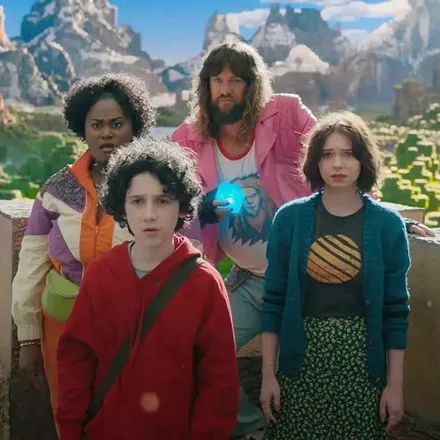Avatar The Way of Water feature movie review
James Cameron's long-awaited sequel showcases the amazing world of Pandora
By Scott Renshaw @scottrenshawJames Cameron's 2009 science-fiction spectacle Avatar might be the biggest box office success of all time, but I believe it also holds a lesser-known distinction: No movie has ever been talked about so much regarding how nobody talks about it. Questions about its "cultural footprint," or whether anyone could remember a single character's name, have lingered for years, as much in genuine puzzlement as in a way to denigrate the film. While Avatar was immersive spectacle and world-building on a remarkable level for an entirely original story, after 13 years, the question kept circling around, feeding on itself: Sure, it sold millions of tickets, but did anyone really care about Avatar?
As it turns out, that's entirely the wrong question. Whether or not anybody was deeply invested in the fate of Jake Sully was quite beside the point, since Avatar's world of Pandora was a wonder of visual invention. Avatar: The Way of Water is nominally about a family, and nominally about characters we met in a previous film, but it's really about what James Cameron can do when given a blank canvas. And what he can do is simply breathtaking.
The Way of Water mostly tracks the real time that has passed since the release of the first film, with Jake Sully (Sam Worthington) and Neytiri (Zoe Saldaña) raising their children on Pandora in the wake of the human "sky people" colonizers being defeated and sent back home. Not surprisingly, the humans eventually return in force, this time to prepare Pandora for an exodus of the entire human race from a dying earth. Jake becomes a leader of the guerrilla opposition to the human invasion, bringing him into conflict with an unexpected adversary: Miles Quaritch (Stephen Lang), whose downloaded memories have been placed in his own Na'vi avatar.
Sully's status as high-value target eventually leads him and his family to exile themselves and seek sanctuary with the seafaring Metkayina branch of the Na'vi family tree. In so doing, the story gives Cameron an entirely new Pandoran ecosystem with which to play—and it is, quite simply, dazzling when The Way of Water journeys under that water to place you in a 3D, high-frame-rate aquarium tank. The original Avatar's world was engrossing not just because Cameron created cool-looking creatures, but because the unique flora and fauna were everywhere; the reefs here become beautiful, rich environments even when the focus isn't on massive new beasts like the whale-like tulkun. An ecological message lingers here in the sense of a planet that behaves like a sentient, unified system, but it's less overtly preachy than it is built on the idea that a planet's diverse life is worthy of awe and respect because it's freaking amazing.
From a narrative standpoint, there's a lot of focus on family dynamics; the word "family" is used enough to make this an honorary Fast & Furious movie. Jake's second son, Lo'ak (Britain Dalton) deals with rebellious second-son issues; Quaritch's son Spider (Jack Champion), who was left behind on Na'vi and has "gone native," wrestles with his dad's cruel history; Kiri, the daughter of Dr. Grace Augustine's avatar (with Sigourney Weaver playing both roles, and kind of killing it as an adolescent version of herself), looks for answers about her mysterious parentage. Some of these issues are set up without clear resolutions, likely building towards the planned third film, but while the material may not be deeply compelling, neither is it distracting. And in a way, drastically reducing the presence of human faces from The Way of Water makes it easier simply to get caught up in these other cultures.
It would be crazy to ignore the action side of The Way of Water, since Cameron's sense for crafting that kind of material remains impeccable. From Lo'ak's encounter with a predatory undersea creature to the climactic battle between Na'vi and humans, the set pieces here are terrific stuff, even if it feels weirdly self-referential for the director of Titanic to set the tense closing scenes in the wreckage of a slowly-sinking boat. Then again, it's a reminder that as a filmmaker, Cameron understands when big emotions and broadly-drawn characters can be a feature of spectacular movies, rather than a bug. I was never concerned during Avatar: The Way of Water about whether I'd still be talking about it a decade hence. I was too engrossed in everything that was stunning about watching it right now.
More by Scott Renshaw
-
Film Reviews: New Releases for April 11
The Amateur, Drop, The Ballad of Wallis Island, Warfare, King of Kings, Sacramento
- Apr 10, 2025
-
Movie reviews: THE BALLAD OF WALLIS ISLAND, WARFARE, THE KING OF KINGS
Wars of words, weapons and ideas drive three new theatrical releases
- Apr 9, 2025
-
The phenomenon of the musical Wicked
Musical theater experts explain why it's beloved both on stage and screen
- Apr 9, 2025
- More »
Latest in Film Reviews
Readers also liked…
-
Sundance 2025 wrap-up plus February special screenings
Uncertainty about the future location shifts focus away from the movies
- Feb 5, 2025










